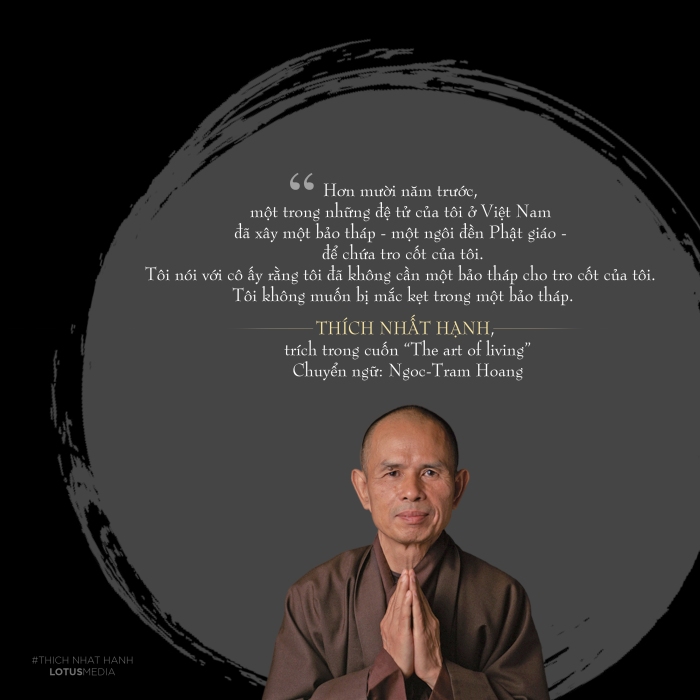“Mắc kẹt trong Bảo tháp”
Thích Nhất Hạnh
Ngoc-Tram Hoang chuyển ngữ
Hơn mười năm trước, một trong những đệ tử của tôi ở Việt Nam đã xây một bảo tháp – một ngôi đền Phật giáo – để chứa tro cốt của tôi. Tôi nói với cô ấy rằng tôi đã không cần một bảo tháp cho tro cốt của tôi. Tôi không muốn bị mắc kẹt trong một bảo tháp. Tôi muốn ở khắp mọi nơi.
“Tuy nhiên”, cô ấy đã phản đối, “bảo tháp đã xây xong rồi!”
“Trong trường hợp đó”, tôi đã nói rằng, “con phải đặt một dòng chữ ở mặt trước của bảo tháp, nói rằng, ‘Tôi không có ở đây’ “. Thực sự là vậy. Tôi sẽ không ở trong bảo tháp. Ngay cả khi cơ thể của tôi được hỏa táng và tro cốt được đặt trong đó, tro đó vẫn không phải là tôi. Tôi không ở trong đó. Tại sao tôi lại muốn ở bên trong đó khi bên ngoài đẹp đến thế?
Nhưng trong trường hợp một số người hiểu lầm, tôi nói với cô ấy rằng họ có thể cần thêm một dòng chữ khác, nói rằng, “tôi cũng không ở bên ngoài kia”. Mọi người sẽ không tìm thấy tôi bên trong hoặc ngoài bảo tháp. Tuy nhiên, họ vẫn có thể hiểu lầm. Vì vậy, có thể cần phải có một dòng chữ thứ ba với nội dung, “Giả hoặc tôi được tìm thấy ở bất cứ nơi đâu, đó là trong cách thở và đi bộ yên bình của bạn”. Đó là sự tiếp nối của tôi. Mặc dù chúng ta có thể chưa bao giờ gặp nhau trực tiếp, nhưng, khi bạn hít vào, bạn thấy sự bình yên trong hơi thở của mình, tôi ở đó với bạn.
Thích Nhất Hạnh, trích trong cuốn “The art of living”
Chuyển ngữ: Ngoc-Tram Hoang
Chuyển ngữ: Ngoc-Tram Hoang
*
Over ten years ago, one of my disciples in Vietnam had a stupa – a Buddhist shrine – built for my ashes. I told her that I didn’t need a stupa for my ashes. I don’t want to be stuck in a stupa. I want to be everywhere.
“But,” she protested, “it’s already built!”
“In that case,” I said, “you’ll have to put an inscription on the front, saying, ‘I am not in here.’” It’s true. I won’t be there in the stupa. Even if my body is cremated and the ashes are put in there, they aren’t me. I won’t be in there. Why would I want to be in there when outside it is so beautiful?
But in case some people misunderstand, I told her they might need to add another inscription, saying, “I am not out there either.” People won’t find me inside or outside the stupa. Yet they may still misunderstand. So there may need to be a third inscription that reads, “If I am to be found anywhere, it is in your peaceful way of breathing and walking.” That is my continuation. Even though we may never have met in person, if, when you breathe in, you find peace in your breathing, I am there with you.
“But,” she protested, “it’s already built!”
“In that case,” I said, “you’ll have to put an inscription on the front, saying, ‘I am not in here.’” It’s true. I won’t be there in the stupa. Even if my body is cremated and the ashes are put in there, they aren’t me. I won’t be in there. Why would I want to be in there when outside it is so beautiful?
But in case some people misunderstand, I told her they might need to add another inscription, saying, “I am not out there either.” People won’t find me inside or outside the stupa. Yet they may still misunderstand. So there may need to be a third inscription that reads, “If I am to be found anywhere, it is in your peaceful way of breathing and walking.” That is my continuation. Even though we may never have met in person, if, when you breathe in, you find peace in your breathing, I am there with you.
Thich Nhat Hanh, in “The Art of Living”.

